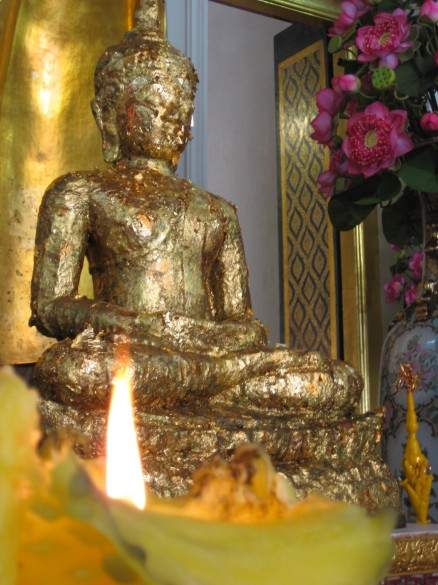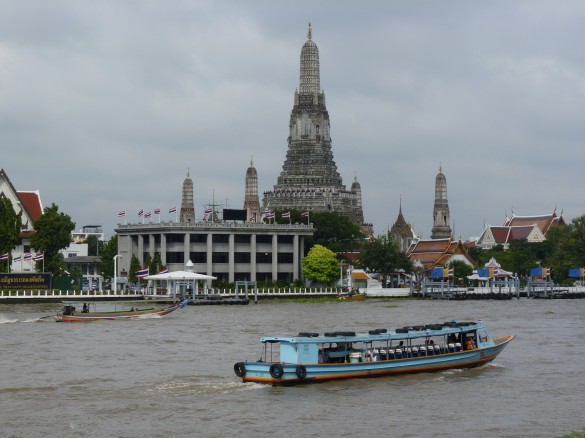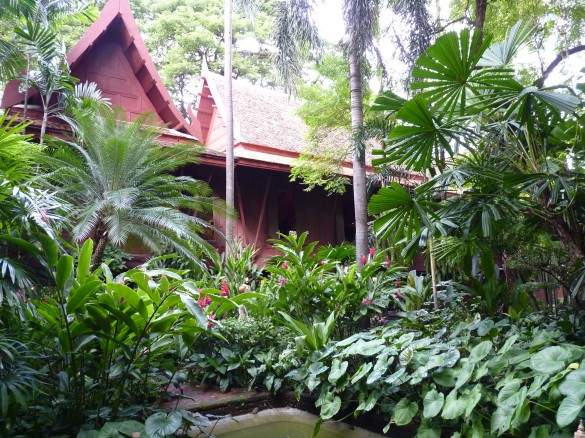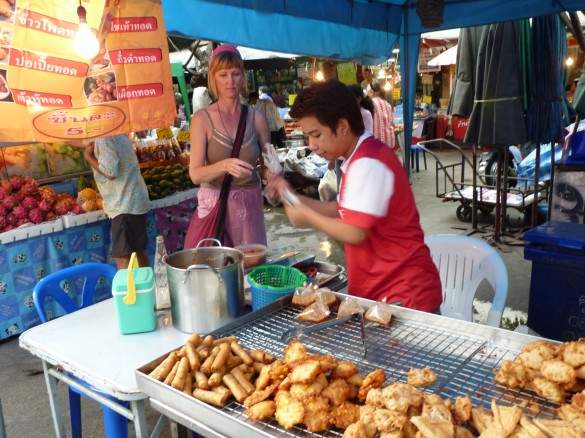If you’re traveling on a budget, Southeast Asia is a great place to do it in. Once you get here, it’s easy to keep costs very low, and have an amazing time on just a few bucks. Take your pick from these three itineraries for a great day in Bangkok, for less than $10 – and easily around $5.
Buddhas, Buddhas Everywhere

Start the day with a visit to one of many incredible temples in Bangkok, before the heat sets in. My favorite is Wat Pho, a royal monastery from the days of King Rama I. While there are literally hundreds of Buddha statues around the sprawling complex – rows and rows of them aligning the courtyard walls and many more in freestanding temples – the big draw is the huge, golden Reclining Buddha. The site of this serene Buddha at the moment of Enlightenment is truly awe-inspiring, and perhaps the most magnificent Buddha I have ever seen. (Cost: 50 baht – $1.60)

From Wat Pho, you can head across the river to Wat Arun – but stop first for lunch at ferry landing #10, where an amazing array of street food stalls can be found. Bangkok is one of the best cities in the world for delicious, cheap street eats; here we had an incredible meal of stir-fried eggplant, chicken with saffron rice, eggrolls and Thai iced-tea. (Cost: 20-50 baht – $1-1.60)
Take the public ferry directly across the river to visit Wat Arun (4 baht), but before you board take advantage of the photo opportunity from the opposite bank. This “Temple of Dawn” was built in a distinctly different style, as the first building of Thailand’s new capital after the sacking of Ayutthaya. Much smaller in scope than Wat Pho, it is impressive for its imposing stone structure adorned with mosaics, and the steep steps that let you climb about halfway up. An enchanting surprise is the collection of golden bells that dangle from the edges of the spires and cast a gentle melody onto the breeze. (Cost: 50 baht – $1.60)
Total Cost Per Person: $4-5
Traditional Thailand of Yesteryear

Begin at the Jim Thompson House, a peaceful enclave that hides an incredible traditional Thai teakwood home, once belonging to American entrepreneur Jim Thompson. Thompson fell in love with Thailand during WWII and returned after the war to make his home here. And what a home it is – six houses were salvaged and put together in this one beautiful building full of an incredible collection of antiquities and artwork, some as old as the 7th century Buddha that graces the entrance courtyard. Thompson was responsible for reviving the handwoven Thai silk industry and creating huge interest through worldwide exportation; he mysteriously disappeared on a hike into the Malaysian jungle in 1967, but his Bangkok home is a cool respite in the bustling city, and a glimpse into bygone Thailand. (Cost: 100 Baht/50 for Students – $3.20/$1.60)
From there, walk east along the river a block or so where you will find a charming waterside restaurant; or climb the stairs, walk across the bridge and down the other side for two equally good canal-side restaurants. Each have fresh, on the spot food and cold beer at extremely reasonable prices. (Cost: 20-60 baht – $1-2)

After lunch it’s time to take in some traditional Thai dancing. Seeing the authentic thing, rather than the many packaged shows put on for tourists, shouldn’t be missed. Just a few blocks south at the Erawan Shrine, located incongruously at the busy intersection of Ratchadamri and Ratchaprasong Roads in the midst of upscale malls and offices, live musicians and elaborately costumed dancers are on call. Erawan Shrine became popular after it was reputed to have protective powers, and locals drop by daily for prayers and to commission dances. The numbers are impromptu and the petitioner gets to sit on the pillow at the dancing platform and pray while his or her dance is performed. This is the real, local insight into Thai dancing. (Cost: Free)
Total Cost Per Person: $3-4
Pound the Markets & Glide on Water

If your trip to Bangkok includes a Saturday or Sunday, head to the Chatuchak Weekend Market. As a huge farmer /artisan/flea market fan, this is one of the best markets I’ve been to anywhere in the world. The massive labyrinth includes loosely organized sections for clothing, housewares, pottery and china, handicrafts, even modern art and incredible antique shops. There are also big pockets of covered restaurant stalls and tables, as well as endless quick drink or snack carts. There are bargains to be had if you fancy shopping, but it’s completely free to enter and be entertained by the myriad sights and sounds. To get there, take the Skytrain (25-40 baht) to the Mo Chit station. (Cost: Free unless you buy something)

On weekdays, browse Chinatown or Khao San Road, both great for people-watching and shopping. Khao San is the original hippie backpacker haven for Western tourists; although it is cheesy and overly touristy now, it’s worth a visit to have a beer and pick up fun (though overpriced) souvenirs. There are also lots of traveler-friendly services such as internet cafes, tourist offices and inexpensive guesthouses, as well as a nightlife scene. Chinatown is sprawling, and much like Chinatowns in other big cities around the world it is full of unrecognizable foods and tiny shops where you can buy everything from ancient Chinese curing herbs to plastic blingy trinkets. There are also some cool temples tucked into the meandering alleys, and Soi Texas enjoys a lively seafood stall scene that pops up in the late afternoon and evening. (Cost: Free unless you buy something)
Before sunset, make your way back to the Chao Phraya River, for a cruise on the public water taxi (14 baht). Along the way you can glimpse amazing temples and a lot of local happenings. The public taxis are comfortable and easy to use, although locals use them for commuting so around 5 pm they can get crowded. I recommend starting about 45 minutes before sunset for the most spectacular views, possibly at the northern end of the river at the Krung Thon Bridge (landing #16), to the Memorial Bridge landing (#6) at the southern end.
Total Cost Per Person (Food & Transport): $3-7